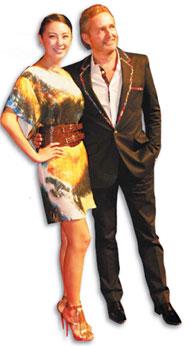
H&M's flower-patterned long folded dress embodies all that is associated with street fashion, namely, comfort, confidence, and mix-and-match.
Reporter Liu Yang, 28, no longer has to struggle to buy clothes of the Swedish fashion brand Hennes & Mauritz (H&M). The brand opened its first Beijing branch in Qianmen, Beijing, on Wednesday.
H&M, known for its reasonable prices and hip designs, opened two stores in Shanghai and Shenzhen in 2007. Every time they came out with a new collection, hordes of their fans would fly to these cities, including Liu.
Brands like H&M, Mango, Zara and Uniqlo are often seen as an inspiration for Chinese street fashions. Unsurprisingly, at a party held on Wednesday evening to celebrate H&M's presence in Beijing, one could see many of the names associated with Chinese street fashions, such as Taiwanese model Joe Zheng, mainland actress Zhang Yuqi and singer Zhang Xiaochen.
Unlike top brands like Gucci and Louis Vuitton, the core principle of these brands is "nice and cheap", says He Shuliang, a fan.
So how cheap and how nice are they? Here is an example: The Japanese brand Uniqlo brings out a collection of cotton T-shirts every summer, priced at 99 yuan ($14.5) apiece, with some even going for 79 yuan ($11.6).
Their youthful designs are a big hit with Chinese fans - from 25 to 40 - and usually feature colorful patterns and graffiti. Last year, they had a collection called Cassette Playa whose tees had colorful bricks, stacked up to look like a cassette player.
"Street fashion, or looking nice on the cheap, is really about being yourself," says Zhang Jing, 27, a Beijing fashion consultant. "It takes time to know what style suits you best. And while you figure that out, street fashion comes in handy as it is easy to access and economical."
For example, reporter Liu goes for the Uniqlo T-shirts as the basic garment and matches them with accessories and other top-brand wear.
Zhang Zhao, vice-president of www.p1.cn, China's first snap shot website, says: "The best snap shots are of people who are good at match-and-mix, and go for cool accessories." Snap shot refers to the random taking of pictures off a street deemed to have the most fashionable people and are seen as capturing current fashions most spontaneously.
The Yay Media Company, which launched a social networking website www.p1.cn in 2007, even sends photographers to Beijing, Shanghai, Guangzhou, Shenzhen and Hong Kong to take such street pictures.

Actress Zhang Yuqi, clad in an outfit of H&M, with Lex Biography, general manager of H&M in China.
"You can see brands like H&M, Mango and Uniqlo, but some also wear Louis Vuitton and Gucci. Not many young people are rich, so they choose brands with low prices but good designs to express their unique style," says Zhang Zhao.
"They are who they are. They do not want to follow any so-called 'trend'. The look they want screams - individualized, personal and comfortable," explains fashion consultant Zhang June.
However, Bao Weiwu, an independent local fashion designer, does not think these brands, including Mango, Zara and Uniqlo, represent Chinese street fashions. "Cheap and nice clothes are one thing, but it is common for brands to 'borrow' ideas from other big names," Bao says.
Actress Zhang Yuqi, clad in an outfit of H&M, with Lex Biography, general manager of H&M in China. Jiang Dong
He believes some collections of these less expensive brands even have the same patterns and styles as the big names, such as Dolce & Gabbana, LV and Marc Jacobs, but "worse material and workmanship".
"We (fashion designers) know about them. Young designers from these brands always bring a sketchbook and pencils to attend the shows of the big names, and then draw what they see. The company makes some variations to what they have drawn, and quickly produces similar clothes, " Bao says.
But this apparently poses no issue for their fans. "These brands have to keep updating their collections and that makes for more choice," says Zhang Jing, a one-time student at the London School of Economics.
She recalls noticing fans of street fashions buying brands like Topshop in London. "But they knew what they wanted to wear, how to match and what to choose," she says.
The main problem with Chinese street fashion fans is that they have no clear idea about the style they want. "Today, independent street fashion can be found in only two places in the world - London and Tokyo. They both have their own unique characteristics," says Bao.
London street fashions are all about campus-skirts, knits, slim cuts, checked patterns and preppies, while the look on Tokyo's streets is more colorful. It is defined by folded short skirts, high-heeled boots, T-shirts with strange cuttings, elaborate accessories, big, colored, hats, and gloves with dots and cartoon patterns.
By contrast, the idea of street fashions is still very new in China. The styles are constantly evolving and even a diehard fan of H&M, like Liu, is not entirely satisfied. "The clothes seem designed more for European and American physiques," she says.





